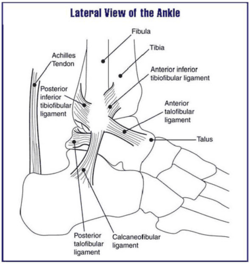Calcaneofibular Ligament Tear Icd 10
- Right Calcaneofibular Ligament Sprain Icd 10 Code
- Calcaneofibular Ligament Injury Icd 10 Code
- Tear Of Calcaneofibular Ligament Icd 10
Lateral ligament injuries are perhaps one of the most common sports-related injuries seen by physiotherapists. Lateral ankle sprains are thought to be suffered by men and women at approximately the same rates; however, it is suggested that female interscholastic and intercollegiate basketball players have a 25% greater risk of incurring grade I. ICD-10 from 2011 - 2016 ICD Code S93.412 is a non-billable code. To code a diagnosis of this type, you must use specify a 7th character that describes the diagnosis 'sprain of calcaneofibular ligament of left ankle' in more detail.
There are many different muscles and ligaments in the ankle, which gives the ankle its strength, flexibility, and range of motion.
Major ligaments of the ankle
Anterior and posterior ankle ligaments.
Ligaments are a type of soft tissue that is made up mostly of collagen. Ligaments have low vascularity, which means they do not receive much blood flow. This lack of blood flow makes ligaments slower to heal than other types of soft tissue.
Right Calcaneofibular Ligament Sprain Icd 10 Code
Unlike tendons, which connect muscle to bone, ligaments connect bones to other bones.
There are several major ligaments in the ankle:
- Three ligaments on the outside of the ankle that make up the lateral ligament complex, as follows:
- The anterior talofibular ligament (ATFL), which connects the front of the talus bone to a long bone in the lower leg called the fibula
- The calcaneofibular ligament (CFL), which connects the calcaneus, or heel bone, to the fibula
- The posterior talofibular ligament (PTFL), which connects the rear of the talus bone to the fibula
- The deltoid ligament, a thick ligament which supports the entire medial, or inner, side of the ankle
- The anterior inferior tibiofibular ligament (AITFL), which connects the tibia to the fibula
- Two posterior fibular ligaments, which crisscross the back of the tibia and fibula:
- The posterior inferior tibiofibular ligament (PITFL)
- The transverse ligament
- The interosseous ligament, which rests between the tibia and fibula and runs the entire length of the tibia and fibula, from the ankle to the knee
The various ligaments that surround the ankle together help form part of the joint capsule, a fluid-filled sac that surrounds and lubricates articulating joints.
Major muscles of the ankle
There are also multiple muscles in the ankle that can be strained, as follows:
- The peroneal muscles (peroneus longus and peroneus brevis), on the outside edge of the ankle and foot. These muscles allow the ankle to bend downward and outward.
- The calf muscles (gastrocnemius and soleus), which are connected to the calcaneus via the Achilles tendon. The tightening and relaxing of the calf muscles enables the ankle to bend downward and upward.
- The posterior tibialis muscle, which supports the arch of the foot and enables the foot to turn inward.
- The anterior tibialis muscle, which enables the ankle and foot to turn upward.1
See Common Running Injuries: Foot Pain
See Common Running Injuries: Calf and Shin Pain
The complexity of the ankle's muscular and ligament structure creates many possible opportunities for injuries when the ankle is pushed beyond its normal range of motion.
References
- 1.Sechrest, R. Ankle anatomy: a patient's guide. eOrthopod.com: http://www.eorthopod.com/ankle-anatomy/topic/159. Accessed November 17, 2014.
Non-Billable Code
Non-Billable means the code is not sufficient justification for admission to an acute care hospital when used a principal diagnosis. Use a child code to capture more detail.7th Character Required
Code requires 7th Character Extension identifier. This 7th Character usually captures Episode of Care information, such as 'Initial Encounter,' 'Subsquent Encounter,' or 'Sequela.'ICD Code S93.412 is a non-billable code. To code a diagnosis of this type, you must use specify a 7th character that describes the diagnosis 'sprain of calcaneofibular ligament of left ankle' in more detail. The 7th characters that can be added, and the resulting billable codes, are as follows:
| 7th Digit | Billable Code | 7th Digit Specifies |
|---|---|---|
| A | S93.412A | initial encounter |
| D | S93.412D | subsequent encounter |
| S | S93.412S | sequela |
What is 7th Character Extension?
For codes less than 6 characters that require a 7th character a placeholder 'X' should be assigned for all characters less than 6. The 7th character must always be the 7th position of a code. E.g. The ICD-10-CM code T67.4 (Heat exhaustion due to salt depletion) requires an Episode of Care identifier. T67.4XXA Initial Encounter or T67.4XXD Subsequent Encounter. More Info
Initial Encounter or T67.4XXD Subsequent Encounter. More InfoCalcaneofibular Ligament Injury Icd 10 Code
The ICD code S934 is used to code Sprained ankle
A sprained ankle, also known as an ankle sprain, twisted ankle, rolled ankle, floppy ankle, ankle injury or ankle ligament injury, is a common medical condition where one or more of the ligaments of the ankle is torn or partially torn.
Tear Of Calcaneofibular Ligament Icd 10
| Specialty: | Orthopedics, Sports Medicine |
| ICD 9 Code: | 845.00 |
Parent Code:S93.41 - Sprain of calcaneofibular ligament